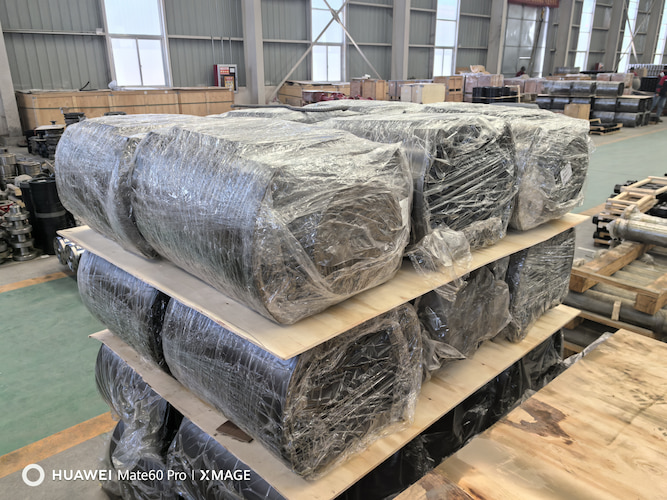Что такое крейцкопфный узел бурового насоса?
Apr 23, 2025
The Крейцкопфный узел бурового насоса является одним из ключевых компонентов грязевого насоса. Ниже приводится подробное введение в каждый из его компонентов:Ⅰ. Сборка крейцкопфаКрейцкопфСтруктура и функция: Обычно это блочная конструкция из литой стали или высокопрочного чугуна. Она служит ступицей, соединяющей шатун и промежуточный стержень. Она преобразует качательное движение шатуна в линейное возвратно-поступательное движение промежуточного стержня и в то же время выдерживает огромное давление и ударную силу во время работы грязевого насоса.Особенности конструкции: Имеет несколько соединительных отверстий и сопрягаемых поверхностей, которые точно соединены и сопрягаются с другими компонентами. Его поверхность обработана для обеспечения хорошего контакта с компонентами, такими как блок скольжения крейцкопфа и штифт крейцкопфа, что снижает износ и трение.Штифт крестовиныСтруктура и функция: Как правило, это цилиндрический металлический штифт, а его диаметр определяется в соответствии со спецификациями и нагрузкой бурового насоса. Он проходит через крейцкопф и малый конец шатуна, соединяя их вместе и передавая мощность и движение.Материал и процесс: Изготовлен из высококачественной легированной стали, такой как 40Cr и т. д. Благодаря таким процессам, как ковка, механическая обработка, закалка и шлифовка, он обладает высокой прочностью, твердостью и износостойкостью. Твердость поверхности обычно составляет около HRC50-55, чтобы выдерживать частые ударные нагрузки. Направляющая доска крейцкопфа бурового насосаСтруктура и функция: Обычно это пара плоских металлических пластин, установленных в фиксированных положениях по обеим сторонам или вокруг траверсы. Ее функция заключается в обеспечении точного направления движения траверсы, гарантируя, что траверса движется вперед и назад по прямой траектории и уменьшая тряску и отклонение.Материал и обработка поверхности: Обычно используемые материалы — износостойкий чугун или бронза. Для повышения износостойкости и снижения коэффициента трения поверхность хромируется или азотируется. Толщина слоя хромирования обычно составляет 0,02-0,05 мм.Грязевой насос Pony RodСтруктура и функция: Это тонкий стержневой компонент, соединяющий крейцкопф и поршень. Он передает линейное движение крейцкопфа поршню, позволяя поршню двигаться вперед и назад в цилиндре насоса, тем самым осуществляя всасывание и нагнетание бурового раствора.Требования к материалам и эксплуатационным характеристикам: используется высокопрочная легированная сталь, например, 35CrMo и т. д. Она имеет высокий предел прочности на растяжение и предел текучести, как правило, с пределом прочности на растяжение более 800-1000 МПа, чтобы выдерживать силы натяжения и давления, возникающие при движении поршня в цилиндре насоса.Подшипник крейцкопфаСтруктура и функция: Устанавливается между траверсой и корпусом машины или другими фиксированными компонентами, используется для поддержки веса и нагрузки движения траверсы. Играет роль в снижении трения, снижении износа и обеспечении гибкого движения траверсы.Типы и характеристики: Распространенные типы включают подшипники скольжения и подшипники качения. Подшипники скольжения обычно используют такие материалы, как баббит или бронза, которые обладают хорошей износостойкостью и противозадирными свойствами и могут выдерживать большие ударные нагрузки, но требуют хороших условий смазки. Подшипники качения имеют преимущества малого коэффициента трения и низкого пускового сопротивления, но они имеют высокие требования к точности установки и смазке.Сальник крейцкопфа бурового насосаСтруктура и функция: Это уплотнительное устройство, установленное между крейцкопфом и корпусом насоса, в основном состоящее из таких компонентов, как сальник, набивка и сальник. Его функция заключается в предотвращении утечки бурового раствора из зазора между крейцкопфом и корпусом насоса, обеспечивая герметичность и эффективность работы бурового насоса.Материал и принцип уплотнения: Набивка обычно представляет собой кольцеобразную конструкцию, изготовленную из таких материалов, как графит, асбест или политетрафторэтилен. При приложении определенного давления к набивке через сальник набивка образует уплотнение в коробке сальника, предотвращая утечку бурового раствора. Уплотнительные свойства коробки сальника напрямую влияют на рабочую среду и эффективность бурового насоса, и набивку необходимо регулярно проверять и заменять.Ⅱ. Принцип работы крейцкопфного узла грязевого насоса заключается в преобразовании вращательного движения коленчатого вала в линейное возвратно-поступательное движение поршня, тем самым реализуя всасывание и нагнетание ила. Конкретный процесс заключается в следующем:Входная мощность: Источник питания грязевого насоса (например, электродвигатель или дизельный двигатель) приводит коленчатый вал во вращение через передаточные устройства, такие как шкивы и шестерни. Коленчатый вал является основным компонентом трансмиссии грязевого насоса, а его вращательное движение является основой мощности для работы всего грязевого насоса.Преобразование движения: вращательное движение коленчатого вала передается на узел крейцкопфа через шатун. Один конец шатуна соединен с шатунной шейкой коленчатого вала, а другой конец соединен с шатунной шейкой крейцкопфа. Когда коленчатый вал вращается, шатун совершает качательное движение. Поскольку крейцкопф ограничен в пределах направляющего диапазона направляющей доски крейцкопфа и может двигаться только линейно, качание шатуна заставляет крейцкопф совершать линейное возвратно-поступательное движение под ограничением направляющей доски крейцкопфа.Передача силы: Во время линейного возвратно-поступательного движения крейцкопфа усилие передается на поршень через укороченный стержень. Один конец укороченного стержня соединен с крейцкопфом, а другой конец соединен с поршнем. Таким образом, линейное движение крейцкопфа передается на поршень, заставляя поршень двигаться вперед и назад в модуле жидкостной части бурового насоса.Перемещение грязи: когда поршень движется вперед и назад в модуль концевой части бурового насоса, он изменяет объем внутри модуля нагнетательной части бурового насоса. Когда поршень движется назад, объем внутри модуля нагнетательной части бурового насоса увеличивается, давление уменьшается, и буровой раствор поступает в модуль нагнетательной части бурового насоса через всасывающий клапан под действием атмосферного давления; когда поршень движется вперед, объем внутри модуля нагнетательной части бурового насоса уменьшается, давление увеличивается, и буровой раствор выдавливается через выпускной клапан, таким образом реализуя процесс всасывания и нагнетания бурового раствора.Подшипник крейцкопфа играет роль в поддержке крейцкопфа на протяжении всего процесса, уменьшая трение и износ во время движения крейцкопфа и гарантируя, что крейцкопф может двигаться линейно и возвратно-поступательно гибко. В то же время сальник крейцкопфа используется для герметизации зазора между крейцкопфом и корпусом насоса, чтобы предотвратить утечку бурового раствора и обеспечить нормальную работу бурового насоса.Ⅲ. Ниже приведены типичные неисправности узла крейцкопфа бурового насоса и способы их устранения:Износ затвораПроявление неисправности: Зазор между ползунком и направляющей пластиной увеличивается, что приводит к тряске крейцкопфа во время движения, что влияет на нормальную работу бурового насоса. В тяжелых случаях это может привести к неравномерному износу между поршнем и гильзой цилиндра, что снижает эффективность бурового насоса.Анализ причины: Длительное возвратно-поступательное движение вызывает трение между ползунком и направляющей пластиной. Такие факторы, как недостаточная смазка, попадание грязи на поверхность трения и плохая износостойкость материала ползуна, ускоряют износ.Решение: Регулярно проверяйте зазор между ползунком и направляющей пластиной. Если зазор превышает указанное значение, зазор можно уменьшить, отрегулировав прокладку. Сильно изношенные ползуны следует своевременно заменить. В то же время убедитесь, что система смазки работает правильно, регулярно заменяйте смазочное масло, очищайте смазочный канал и не допускайте попадания загрязнений.Износ или поломка пальца крейцкопфаПроявление неисправности: На поверхности пальца крейцкопфа появляются следы износа, точечные выбоины или трещины. В тяжелых случаях палец крейцкопфа ломается, что приводит к выходу из строя соединения между крейцкопфом и шатуном, и буровой насос не может нормально работать.Анализ причин: Штифт крейцкопфа несет большую переменную нагрузку во время рабочего процесса и также подвержен влиянию таких факторов, как условия смазки и точность сборки. Если есть такие проблемы, как плохая смазка, плохое качество материала штифта крейцкопфа или эксцентриситет или чрезмерный зазор во время сборки, это может привести к износу или поломке штифта крейцкопфа.Решение: Выберите надежный материал для пальца крейцкопфа и строго контролируйте точность обработки и качество сборки пальца крейцкопфа. Регулярно проверяйте состояние износа пальца крейцкопфа и своевременно заменяйте его при обнаружении износа или трещин. Усилить управление смазкой, чтобы обеспечить хорошую смазку в сопрягаемых частях пальца крейцкопфа с корпусом крейцкопфа и малым концом шатуна.Трещины в корпусе крейцкопфаПроявление неисправности: На поверхности или внутри корпуса крейцкопфа появляются трещины, что может привести к снижению прочности корпуса крейцкопфа и даже к его разрушению, что влияет на безопасную работу бурового насоса.Анализ причин: Корпус крейцкопфа испытывает сложные нагрузки во время работы, такие как инерционная сила, создаваемая возвратно-поступательным движением, и ударная сила, вызванная давлением бурового раствора. Если в материале корпуса крейцкопфа есть дефекты, необоснованный процесс литья, длительная работа под высокой нагрузкой или ненормальный удар, могут возникнуть трещины.Решение: Проведите дефектоскопию корпуса крейцкопфа, чтобы своевременно обнаружить потенциальные трещины. Для небольших трещин можно использовать метод ремонта сваркой, но следует уделять внимание процессу сварки, чтобы предотвратить образование новых трещин. Для корпусов крейцкопфа с серьезными трещинами следует заменить новые компоненты. При ежедневном использовании избегайте перегрузки грязевого насоса и уменьшайте ненормальные удары.Закупорка канала смазочного маслаПроявление неисправности: смазочное масло не может нормально подаваться к каждой трущейся детали, что приводит к повышению температуры узла крейцкопфа и его износу.Анализ причины: Примеси, шлам или металлический мусор в смазочном масле могут заблокировать масляный канал. Кроме того, несоответствующая вязкость смазочного масла, слишком высокая или слишком низкая температура масла также повлияют на текучесть масла, что приведет к блокировке масляного канала.Решение: Регулярно прочищайте канал смазочного масла, а для промывки можно использовать специальные чистящие средства или масло высокого давления. Заменяйте смазочное масло, которое соответствует требованиям, регулярно проверяйте качество масла, а загрязненное масло своевременно фильтруйте или заменяйте. В то же время убедитесь, что температура масла в системе смазки находится в пределах нормы, а для контроля температуры масла можно установить устройство регулирования температуры масла.
ЧИТАТЬ ДАЛЕЕ





 Language :
Language : Русский
Русский English
English عربي
عربي
 Получить предложение
Получить предложение




 IPv6 ПОДДЕРЖИВАЕТСЯ СЕТЬЮ
IPv6 ПОДДЕРЖИВАЕТСЯ СЕТЬЮ
